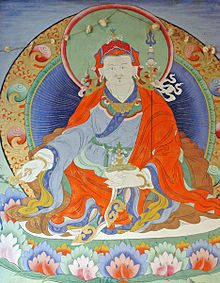 |
| Padma Sambhava |
Padma Sambhava, the Vajra Guru in Tibetan Vajrayana Buddhism, is a widely revered figure, and his imagery is seen in many monasteries, temples and on frescoes and thangkas alike. His contributions to the introduction of Buddhism into Tibet is well recorded in Tibetan Buddhist literature, where a mix of belief and history overlap to identify him as a very powerful mystical figure. It is interesting though that very few people realize and remember the link of Pamda Sambhava with India. Even fewer are aware of the link of Padma Sambhava with Himachal Pradesh.
Among Tibetans, Mandi was always known as Zahor, from where the great Guru Padma Sambhava had come at the behest of the then Tibetan king Trisong Detsen somewhere between 750-800 A.D.. As noted by Hutchison and Vogel in their magnum opus on the Punjab Hill States, Padma Sambhava appeared in Tibet in the ancient dress of Mandi, which even today is known as
Zahorma by the Tibetans. Zahor is the place from where several Buddhist texts were introduced into Tibet in the first place. Tibetans still believe that during the rule of the Buddhist persecuting king Langdarma, many texts were taken away to Zahor or Mandi, and hidden somewhere in the region.
Hutchison and Vogel had noted that Tibetans used to come for pilgrimage to a holy lake in Mandi they called
Padmacan or
Co Pema, where the spirit of Padma Sambhava, whom they worship, is still believed to reside on the lake's floating islands. This lake, better known as Rewalsar in India, is equally holy to the local Mandi residents as well, as it is the place identified to be the residence of Lomasa Rishi, who finds extensive reference in the
Skanda Purana. It is interesting to note that Hutchison and Vogel seem to note the identification of Padma Sambhava as Lomasa Rishi. Lomasa Rishi find extensive reference even in the Mahabharata as the sage who went on a pilgrimage with Yudhishthira, and was known as the man whose curse led to the birth of the great scholar Kakabhushundi.
Interestingly, some scholars have argued that Mandi is named after
Mandarava, one of the two principal consorts of Padma Sambhava, who as
per legend was the local princess and later an important disciple of the
Guru. Her temple, sacred equally to both local Hindus as well as
Tibetan Buddhists, still stands today near the banks of the Beas River in Mandi, and is famous by the name of
Mata Kuan Rani's temple. It used to be a major pilgrimage site for Tibetan Buddhists before the Chinese invaded Tibet and sealed off the border in 1949, since which their numbers have significantly fallen.



Comments
Post a Comment